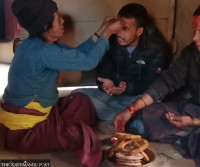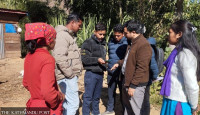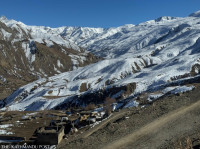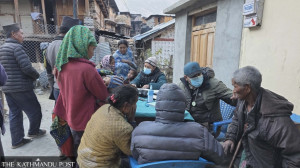Karnali Province
Helicopter rescue the only chance of survival for pregnant women in remote areas of Karnali
There are 274 birthing centres across villages in the province, yet the plight of pregnent women and new mothers remains pitiable. Only this fiscal year, 40 women have been airlifted.
Chandani Kathayat
On June 20, Anisha Budha, 16, of Tripurasundari in Dolpa went into labour. The young mother-to-be was taken to the District Hospital in Dunai, the district headquarters of Dolpa, where the doctors found the baby to be in a breech position—which meant the baby’s buttocks and feet were positioned to be delivered first, a position that can increase the risk for the baby to get stuck in the canal and the umbilical cord to get stuck, cutting off the supply of oxygen for the baby.
The hospital doesn’t have a caesarean section facility, so she had to be airlifted to the Provincial Hospital in Surkhet in a helicopter.
On the same day, Amrita Malla, 21, of Soru in Mugu, also had to be airlifted to the Provincial Hospital after facing complications with her delivery.
There are 274 birthing centres across villages in Karnali Province, yet the plight of pregnant and new mothers remains pitiable. Helicopter rescues to the provincial hospital are the only means of ensuring these women who have birthing complications have successful deliveries. “We have a birthing centre in our village but it’s quite far from our house. And these centres aren’t well-facilitated to handle pregnancy complications,” said Ratna Shahi, a Kalikot local. Several women have had to live through difficult pregnancies in their village for lack of a good hospital, said Shahi. “Many lives would have been lost if there were no helicopter rescues of pregnant women,” he added.
Binod Acharya, officiating director at the Health Directorate, said that most of the birthing centres do not provide effective services due to lack of human resources. “The federal government’s adjustment of government employees has made the situation dire in remote areas. There were few good employees to begin with, and now with the employee adjustment programme, even they have left,” he said.
Given the dearth of qualified health workers, the health posts are manned by those who are ill-equipped to handle complicated pregnancies. They are only trained to extend normal delivery services to pregnant women, say locals. Lawana Dharala, a resident of Jagadulla, gave birth to a stillborn baby a few days ago in the Provincial Hospital in Surkhet. She had lost hope of surviving the difficult delivery, she told the Post. “I had given up. I was in so much pain. Had it not been for the helicopter rescue, I wouldn’t have survived,” she said. It takes two days to reach the district headquarters by road from her village. “I would’ve died if I had to travel for two days to receive treatment.”
Five years ago, the Ministry of Health and Population had started the helicopter rescue programme to prevent the death of pregnant or new mothers under the Safe Motherhood Programme. From the last fiscal year, the federal government started the helicopter rescue programme for pregnant or new mothers with complications from remote parts of the country. Anju Dhungana, chief at the Airlift Programme under the President’s Women Uplift Programme, said that they have already rescued 62 pregnant women from various parts of the country this year. Among them, 40 were from Karnali Province.
According to the Family Welfare Division, for every 100,000 live births, 229 women still die during or after birth in the country every year. The data of the Ministry of Social Development showed that around 32-33 pregnant or new mothers lost their lives every year, before the start of the helicopter services in the province. Now the number has been reduced to 12, said Acharya.




 16.12°C Kathmandu
16.12°C Kathmandu












